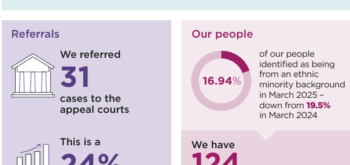This is is the second part of a two-part history of the CCRC. You can read the first part (The Waiting Game) here.
It is not the first time in history that the Court of Appeal has been an impediment to cases being reopened. There have been battles in the past on the psychology of the Court of Appeal. They have been essential to wage. The Court of Appeal was shamed into admitting that year after year, decade after decade, they kept innocent people in prison.
Gareth Peirce, speaking at the launch of the Justice Gap’s Wrongly accused in 2012
Two years ago an influential group of MPs delivered their assessment on the miscarriage of justice watchdog. The House of Commons’ justice committee concluded that the Criminal Cases Review Commission was ‘performing its functions reasonably well’.
If that was hardly a ringing endorsement for the CCRC set up 20 years ago last month, it was perhaps more than could be reasonably expected in the circumstances. The CCRC’s own chair Richard Foster had been unsparing in his own assessment of life under the financial constraints foisted upon the first state-funded miscarriage watchdog.
Foster told the MPs that the commission had suffered ‘the biggest cut that has taken place anywhere in the criminal justice system’. ‘For every £10 that my predecessor had to spend on a case a decade ago, I have £4 today,’ he said.
Foster used the opportunity to make the case for more money. For just a £1 million – ‘the cost of one of the Navy’s Tomahawk missiles’, as he told the committee – the CCRC could eliminate its queues, he said.
The CCRC was set up as a response to the public outrage following scandals such as the Birmingham Six, as I recalled in the first installment of this two-part article. The way successive governments have undermined the body has been another scandal, of different magnitude but a scandal nonetheless.
It was 10 years ago that the law reform group JUSTICE published a book by the former CCRC commissioner Laurie Elks (Righting Miscarriages of Justice: 10 years of the CCRC, 2008). Elks noted that the CCRC ‘generously funded in its early years’ had quickly become ‘regulated from a spirit of underlying hostility’.
Foster’s predecessor, Professor Graham Zellick was even more outspoken when I interviewed him around the same time. The former vice chancellor of the University of London described his staff as ‘frustrated… angry and dispirited’. ‘If you compare our £8 million budget with the amount of money spent on the other side by the police and the Crown Prosecution Service, it isn’t even a crumb off the table,’ Zellick told me.
In his book, Laurie Elks also noted the souring of the relationship between the CCRC and the Court of Appeal. The appeal judges had already ‘wearied’ of its referrals and had ‘not hesitated to administer a prefectorial ticking off when it considers that the Commission has overreached itself’, he said.
A bolder approach
Laurie Elks identified the case of Tony Stock to illustrate the failings of the Court Appeal to get to grips with miscarriage cases. I wrote a book about the Stock case (The First Miscarriage of Justice, Waterside Press, 2014). Tony Stock was jailed in 1970 for his part in an armed robbery in Leeds. It is an outrageous case which was to go to the Court of Appeal on four occasions and was the first to be referred back twice to the Court of Appeal by the CCRC. The prosecution case has totally collapsed over the last 46 years. It could quite possibly be that the only people who believe Stock did it are Court of Appeal judges.
Elks cited Stock’s travails in the Court of Appeal as an example of a shift by the appeal judges from what he called a broader ‘holistic’ approach to a narrower ‘atomistic’ approach. Speaking in 2014 at my book launch, Elks made clear his view that the Appeal judges were ‘perpetuating’ a miscarriage of justice in the case of Stock.
The former commissioner argued that if the CCRC was to fail to refer the case then the family could judicially review the watchdog to force a referral. ‘If on the other hand, the judiciary closes ranks and decides that it is expedient to perpetuate this miscarriage of justice, then it will be a matter for politicians and legislators to resolve,’ he added.

At the 2012 launch debate of the Justice Gap’s Wrongly Accused publication (here), David Jessel, the journalist who presented Rough Justice and Trial & Error as well as being a commissioner, called his former colleagues ‘some of the most committed, buccaneering types I know’.
What miscarriage of justice campaigners were all about was banging on the doors of the Court of Appeal and sending cases back until they got it bloody right – whether it was Carl Bridgewater or the Birmingham 6. Sending it back until the penny dropped.
David Jessel
But the CCRC was ‘constrained by real possibility’. If the CCRC’s powers of investigation were ‘the good fairy at the christening of the CCRC, then real possibility was the bad fairy’, he said. He has called it it’s ‘baptismal curse’.
The Court of Appeal had always been like that, said the veteran human rights lawyer Gareth Peirce. She said: ‘It has always behaved when there is an appeal like headmaster expelling a pupil: “I do not wish to see you in my school again…”.’
She referred to the case of David Cooper and Michael MacMahon ‘which went back five and on the fifth time the commission – I give you credit there – sent it back’.
The CCRC’s then deputy chair Alastair MacGregor said that if the commission was to start sending cases back to the Court of Appeal which they thought were a complete waste of time ‘you can bet your bottom dollar the Court of Appeal would be very quickly pushing for a change in legislation’.
The court had ‘reason to be concerned about being deluged with what they might see as unworthy appeals’, he said. MacGregor continued: ‘My own view is that we should be able in exceptional circumstances – if it is in the interests of justice – to refer a case even though we do not think there is a “real possibility” to make the Court of Appeal justify itself even if we do not really think it is going to have an effect.’
However MacGregor said that such an approach built up ‘scope for conflict’ with the court. ‘The number of times it is right for us to do so will have to be fairly limited,’ he said.
The veteran human rights lawyer Gareth Peirce said she was ‘profoundly shocked’. ‘It is intensely disturbing,’ she said. ‘It is if you are budgeting the number of innocent people who can get their cases before the Court of Appeal. If this room was full of people who were all innocent in prison and they heard this, I think they would be utterly horrified at the basis on which you are making decisions.’
Peirce argued this was ‘not the first time in history the Court of Appeal has been an impediment to cases being reopened’.

Image from ‘More Rough Justice’ by Peter Hill, Martin Young and Tom Sargant, 1985
Three years later the justice committee urged the CCRC to be ‘less cautious’ and refer more cases back to the Court of Appeal. ‘If a bolder approach leads to five more failed appeals but one additional miscarriage being corrected, then that is of clear benefit,’ they said.
Their own report drew heavily on the research of Dr Stephen Heaton who had been allowed access to the commission’s files. He reported that nine out of 10 applications to the CCRC had no prospects of even being looked at by the body. Of the total number of applications, some 3.5% were referred to the Court of Appeal. The academic focused on 147 such cases where the CCRC did not refer and identified 26 where there was concern of a potential miscarriage of justice (dubbed the ‘Birmingham 26’). Of that number, Dr Heaton came to the conclusion that the CCRC was right not to refer them based on the current statutory test. ‘That’s a very important finding in a really serious piece of research,’ Professor Michael Zander QC, emeritus professor at LSE told the MPs.
Dr Heaton has also pointed out that his study is now ‘six years old. The world moves on’. He reckons that referral rate has dropped to 3% and could be as low as 1% (if you disregard asylum cases). He also points to increasingly thin statements of reason for those cases it rejects and a run of adverse judgments in the Court of Appeal.
As I explained in the first part, the likes of JUSTICE’s Tom Sargant had been arguing for years before the 1994 royal commission that the problem was the Court of Appeal and its lack of preparedness to remedy miscarriages.
That was a theme of the 2015 justice committee report. ‘The Court of Appeal has always taken the view that they do not want to get involved with jury decisions. They simply wash their hands,’ Prof Zander told the MPs.
A submission by Cardiff University co-signed by 18 academics together with campaigners and lawyers, argued that the CCRC lacked independence and simply served to reinforce ‘the traditional intransigence’ of the Court of Appeal. That submission quoted the Stock case as an illustration of such intransigence.
Their most significant recommendation of the MPs was for the Law Commission to review the court’s grounds for allowing appeals. Michael Gove ditched that proposal on the assurance of a belated written submission by a former Lord Chief Justice (i.e., the former head of the very organisation that was being criticized). ‘We note the views expressed by Lord Judge, and we do not believe that there is sufficient evidence that the Court of Appeal’s current approach has a deleterious effect on those who have suffered miscarriages of justice,’ the then Lord Chancellor wrote.
The Justice Committee must be wondering why it bothered wading through 47 written statements, and taking evidence from 12 experts. The Law Commission recently announced that the issue has been shortlisted as a possible area of inquiry.








